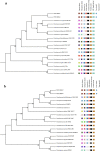Comparative genomic analysis of two Arctic Pseudomonas strains reveals insights into the aerobic denitrification in cold environments
- PMID: 37697269
- PMCID: PMC10494350
- DOI: 10.1186/s12864-023-09638-1
Comparative genomic analysis of two Arctic Pseudomonas strains reveals insights into the aerobic denitrification in cold environments
Abstract
Background: Biological denitrification has been commonly adopted for the removal of nitrogen from sewage effluents. However, due to the low temperature during winter, microorganisms in the wastewater biological treatment unit usually encounter problems such as slow cell growth and low enzymatic efficiency. Hence, the isolation and screening of cold-tolerant aerobic denitrifying bacteria (ADB) have recently drawn attention. In our previous study, two Pseudomonas strains PMCC200344 and PMCC200367 isolated from Arctic soil demonstrated strong denitrification ability at low temperatures. The two Arctic strains show potential for biological nitrogen removal from sewage in cold environments. However, the genome sequences of these two organisms have not been reported thus far.
Results: Here, the basic characteristics and genetic diversity of strains PMCC200344 and PMCC200367 were described, together with the complete genomes and comparative genomic results. The genome of Pseudomonas sp. PMCC200344 was composed of a circular chromosome of 6,478,166 bp with a G + C content of 58.60% and contained a total of 5,853 genes. The genome of Pseudomonas sp. PMCC200367 was composed of a circular chromosome of 6,360,061 bp with a G + C content of 58.68% and contained 5,801 genes. Not only prophages but also genomic islands were identified in the two Pseudomonas strains. No plasmids were observed. All genes of a complete set of denitrification pathways as well as various putative cold adaptation and heavy metal resistance genes in the genomes were identified and analyzed. These genes were usually detected on genomic islands in bacterial genomes.
Conclusions: These analytical results provide insights into the genomic basis of microbial denitrification in cold environments, indicating the potential of Arctic Pseudomonas strains in nitrogen removal from sewage effluents at low temperatures.
Keywords: Aerobic denitrification; Arctic; Cold adaptation; Heavy metal resistance; Pseudomonas.
© 2023. BioMed Central Ltd., part of Springer Nature.
Conflict of interest statement
The authors declare no competing interests.
Figures








Similar articles
-
Enhanced nitrogen removal from low-temperature wastewater by an iterative screening of cold-tolerant denitrifying bacteria.Bioprocess Biosyst Eng. 2022 Feb;45(2):381-390. doi: 10.1007/s00449-021-02668-7. Epub 2021 Dec 2. Bioprocess Biosyst Eng. 2022. PMID: 34859268
-
Insight into the Cold Adaptation Mechanism of an Aerobic Denitrifying Bacterium: Bacillus simplex H-b.Appl Environ Microbiol. 2023 Feb 28;89(2):e0192822. doi: 10.1128/aem.01928-22. Epub 2023 Jan 19. Appl Environ Microbiol. 2023. PMID: 36656033 Free PMC article.
-
[Nitrogen Removal Characteristics and Metabolism Mechanism of High-Efficiency Cold-Tolerant Heterotrophic Nitrification-Aerobic Denitrification Bacterium Glutamicibacter sp. WS1 for Various Nitrogen Sources at Low Temperature].Huan Jing Ke Xue. 2023 Sep 8;44(9):5006-5016. doi: 10.13227/j.hjkx.202210055. Huan Jing Ke Xue. 2023. PMID: 37699818 Chinese.
-
[Denitrifying phosphate accumulating organisms and its mechanism of nitrogen and phosphorus removal].Sheng Wu Gong Cheng Xue Bao. 2023 Mar 25;39(3):1009-1025. doi: 10.13345/j.cjb.220634. Sheng Wu Gong Cheng Xue Bao. 2023. PMID: 36994568 Review. Chinese.
-
Simultaneous denitrification and phosphorus removal: A review on the functional strains and activated sludge processes.Sci Total Environ. 2022 Aug 20;835:155409. doi: 10.1016/j.scitotenv.2022.155409. Epub 2022 Apr 22. Sci Total Environ. 2022. PMID: 35469879 Review.
References
-
- Hao ZL, Ali A, Ren Y, Su JF, Wang Z. A mechanistic review on aerobic denitrification for nitrogen removal in water treatment. Sci Total Environ. 2022;847:157452. - PubMed
-
- Qiao ZX, Wu YG, Qian J, Hu SH, Chan JW, Liu XY, Sun R, Wang WD, Zhou B. A lab-scale study on heterotrophic nitrification-aerobic denitrification for nitrogen control in aquatic ecosystem. Environ Sci Pollut Res Int. 2020;27(9):9307–9317. - PubMed
-
- Shukla S, Rajta A, Setia H, Bhatia R. Simultaneous nitrification-denitrification by phosphate accumulating microorganisms. World J Microbiol Biotechnol. 2020;36(10):151. - PubMed
-
- Silva LCF, Lima HS, Mendes TADO, Sartoratto A, Sousa MDP, Souza RSD, Paula SOD, Oliveira VMD, Silva CCD. Heterotrophic nitrifying/aerobic denitrifying bacteria: ammonium removal under different physical-chemical conditions and molecular characterization. J Environ Manag. 2019;248:109294. - PubMed
-
- Ronan E, Aqeel H, Wolfaardt GM, Liss SN. Recent advancements in the biological treatment of high strength ammonia wastewater. World J Microbiol Biotechnol. 2021;37(9):158. - PubMed
MeSH terms
Substances
Grants and funding
LinkOut - more resources
Full Text Sources

